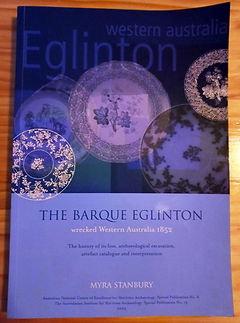
Eglinton
GPS: S 31° 38.552' E 115° 39.523'
Location: Mindarie
Site depth: 4.5 metres
Divable conditions: <1.0m swell
Visibilty: 5-10 metres
Vessel: 3 masted timber Barque
Construction: Timber
Tons: 460 tons
Vessel length: 36 metres
Wreck event: Wrecked on reef 1852
The Eglinton departed London in April 1852 with settlers and supplies for the two-decade old Swan River Colony. Six months later the 460 ton barque hit a submerged reef in the middle of the night just north of Fremantle. The initial impact dislodged the rudder, and the vessel began flooding as it drifted off the first reef and finally wrecked in shallow water on the southwestern section of Pamela Shoal. When the sun rose the next day passengers were ferried ashore by the crew, one female passenger was killed and a crew member severely inured when the ships boat was overturned in the surf.
Read about the loss of the Eglinton at:





The Site:
Little remains of the the timber vessel wrecked over 170 years ago. The site is located on the western side of the southern reef on Pamela Shoal, only 15 minutes north by boat from Mindarie marina boat ramp. Most of the site sits at a depth between 2 and 5 metres around 20 metres from breaking waves, it is there for necessary to anchor in one of the sand patches west of the site away from the forming waves and swim to the location of the wreck. The site consists of a series of limestone caves, overhangs and sink holes in an area 30 metres by 20 metres that contain the remains of the Eglinton's cargo that was once destined for the Swan River Colony. Gravel scatter dominates the numerous caves and natural sink holes and amongst the gravel broken china, green glass and building bricks can be found littering the site. The site, excavated in 1971 once held some of the most intact examples of cargo held from any West Australian shipwreck and artefacts can now be viewed at the WA Museum's Shipwreck Galleries in Fremantle on Cliff Street. Anything remaining on site today is fully protected from disturbance or interference under the Historic Shipwrecks Act.
Gravel Scatters:
The stones are listed by the WA museum as being Thames Valley Flint gravel and were collected through manual labour, from the riverbed of the river Thames in London by poor, working class men known as ballast-getters. The gravel would be dredged from the riverbed and ferried by barge "lighters" to waiting ships to be used as ballast. In April 1852 the 460 ton barque Eglinton was one such ship that took on ballast and was also loaded in the London port with settlers and supplies for the newly established Swan River Colony.
This extract obtained from thamesdiscovery.org is from the writings of Henry Mayhew, a 19th century writer who documented the lives of the English working class:
"the Ballast-Getters are men employed in raising ballast from the river by bodily labour. The apparatus by which this is effected consists of a long staff or pole, c.35ft ( c.11m) long. At the end is an iron spoon or ring, underneath which is a leathern bag holding about 20 cwt (2240lbs). The working lighters carry six hands: a staffsman whose duty is to attend the staff; a bagsman who empties the bag (as it comes on board); a chainsman, who hauls at the chain, a heelsman (for the winch); two trimmers who spread the ballast in the lighter as fast as it come in (to prevent the lighter over-turning)… Ballast-Getters are all very powerful men: they are mostly very tall, big-boned and muscular. Many of them are upwards of 6ft high, and have backs 2ft broad. “I lifted seven half hundred weights with one of my hands” said one…"

